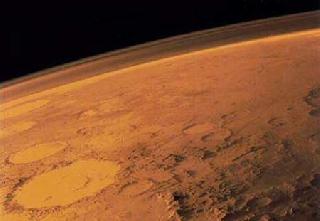
LONDON (PTI): Mars was once rich in carbon dioxide, space scientists have claimed, hinting that the Red Planet could have harboured life some hundreds of millions of years ago.
Small amounts of carbonate rocks have already been detected on Mars. Now a team found that there are extensive deposits of the mineral a few miles beneath its surface.
Extensive deposits of the mineral means the greenhouse gas could have helped make the planet a much wetter and warmer place hundreds of millions of years ago, they said.
Led by Dr Joseph Michalski of the Planetary Science Institute in Arizona and Dr Paul Niles of the NASA Johnson Space Centre in Houston, the scientists used satellite data to analyse the geology of a region known as the Leighton Crater near the enormous Martian volcano Syrtis Major.
This revealed extensive deposits of the mineral almost four miles below the planet's crust that were exposed by a massive meteorite impact, the Telegraph reported.
The scientists believe the deposits represent ancient sediments that were subsequently buried by volcanic material ejected during eruptions from Syrtis Major which is almost 750 miles wide.
The mineral probably came from carbonate-rich water which interacted with the rock -- pointing to early Mars being hotter than previously thought.
The surface of Mars is currently cold, dry, acidic and inhospitable to life. Similar conditions might have persisted for billions of years, the scientists said, suggesting that the best place to search for habitable environments is the subsurface.
Reporting their findings in the Nature Geoscience, the researchers said: "One hint of habitable conditions at depth is the presence of atmospheric methane, which may have formed through hydrothermal processes in the crust, in the presence of carbon dioxide.
"The observation of hydrated minerals excavated by some impact craters suggests that ancient hydrothermal systems may have existed in the subsurface, but until now, none of those deposits has been linked to carbonate minerals and carbon dioxide-rich environments.
"Previous detections of carbonate minerals that could be linked to an ancient carbon dioxide-rich surface environment have been sparse."
A dense carbon dioxide atmosphere would mean some kind of greenhouse effect on Mars. The atmosphere now is very thin so the gas could have blown into space or interacted with water and become present in the rocks.
The carbonate is also evidence that the water was chemically neutral, which would have made conditions more permissive for life on early Mars, they said.
The researchers added: "The mineral assemblage, textural properties and geologic context of the deposits indicate that these rocks are probably ancient sediments that were metamorphosed during burial by younger volcanic materials from the nearby Syrtis Major volcano.
"We suggest that these buried layered carbonates might be only a small part of a much more extensive ancient carbonate sedimentary record that has been buried by volcanic resurfacing and impact ejecta.
"Our discovery may help explain the origin of other carbonates on Mars and indicates a high-priority site for future exobiological exploration."
 Previous Article
Previous Article Next Article
Next Article













The Indian Air Force, in its flight trials evaluation report submitted before the Defence Ministry l..
view articleAn insight into the Medium Multi-Role Combat Aircraft competition...
view articleSky enthusiasts can now spot the International Space Station (ISS) commanded by Indian-American astr..
view article